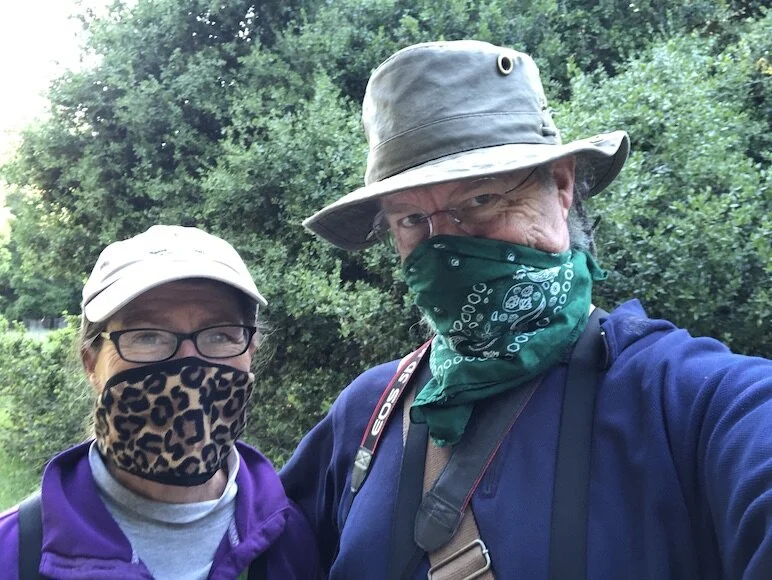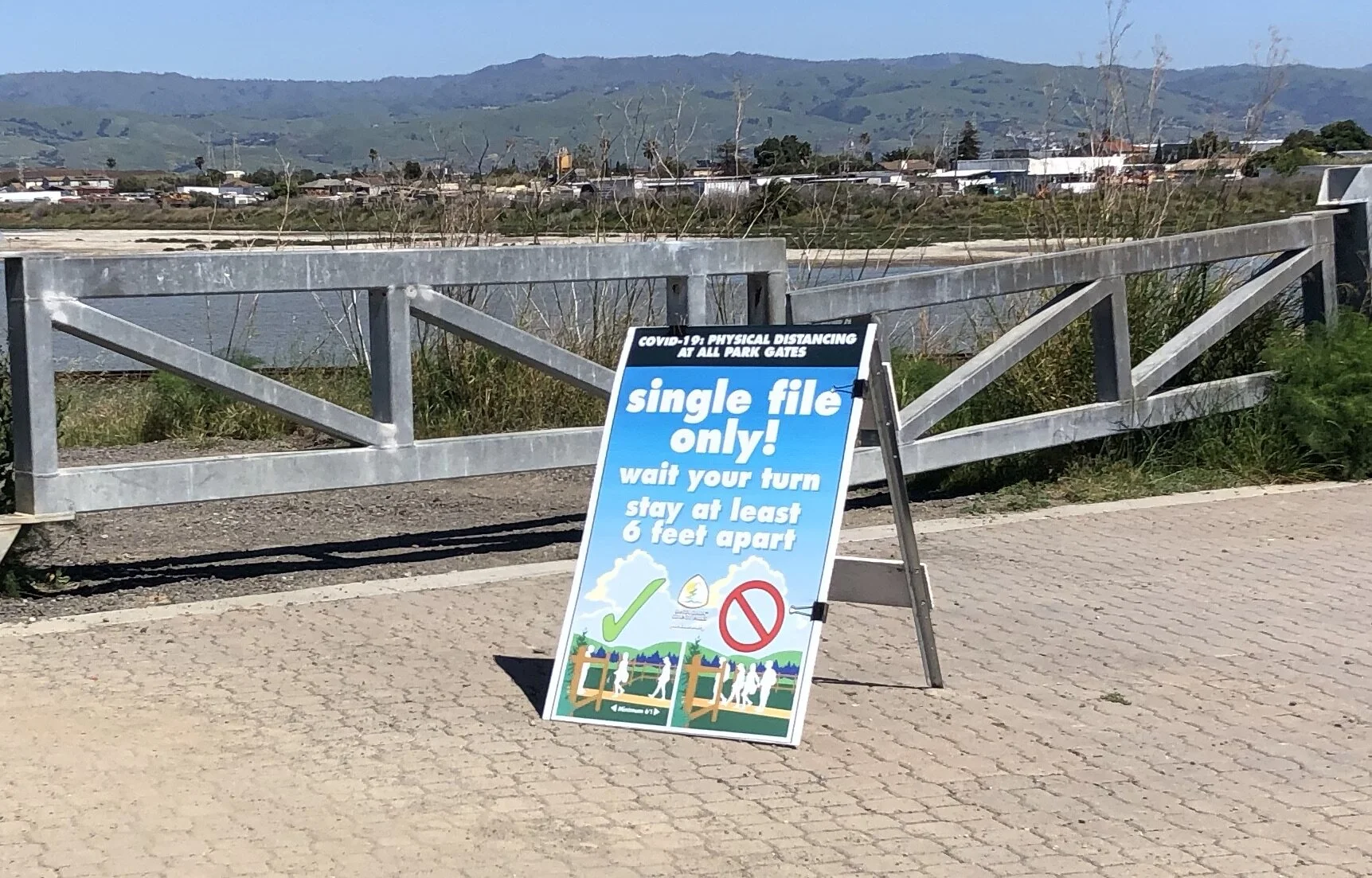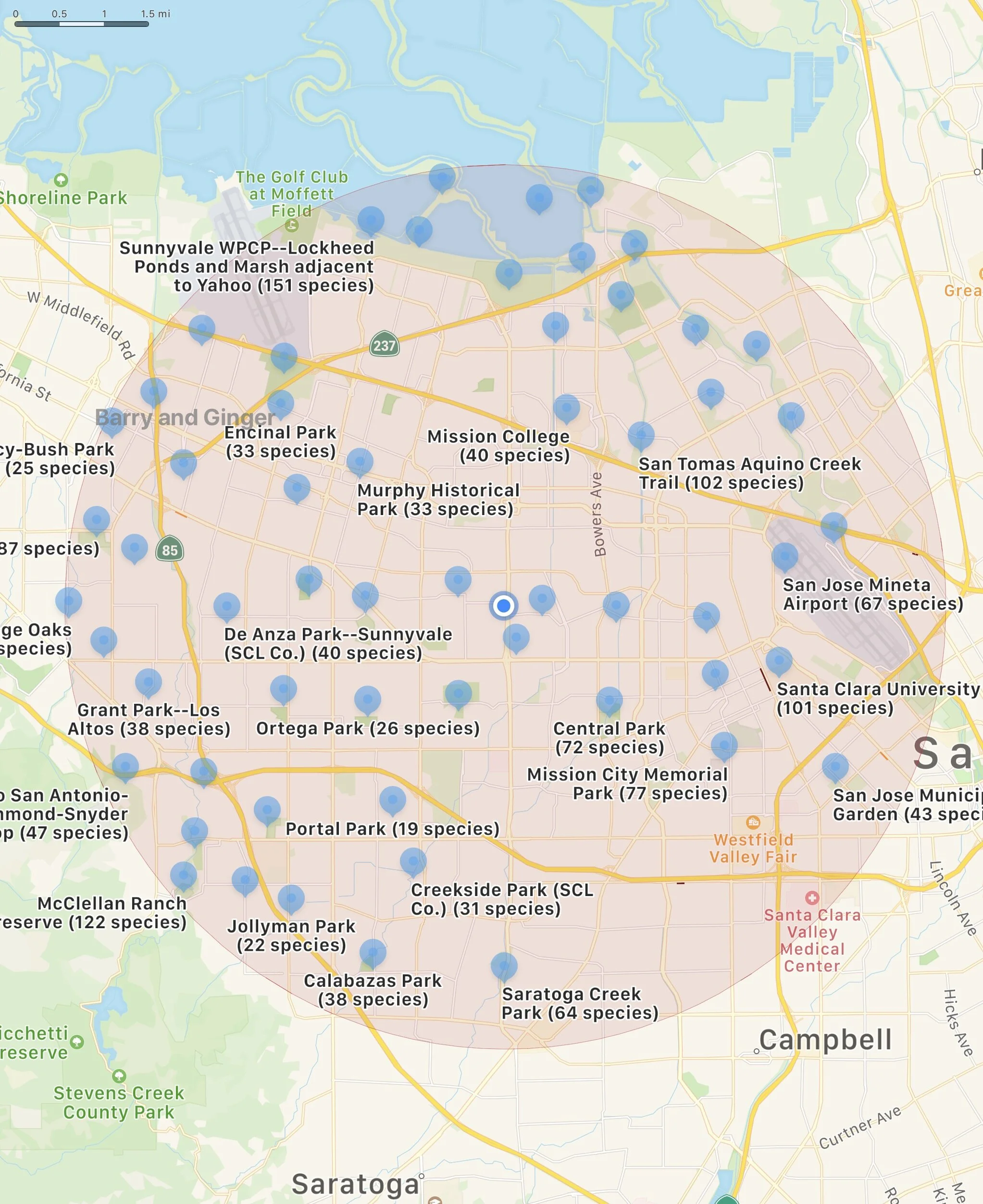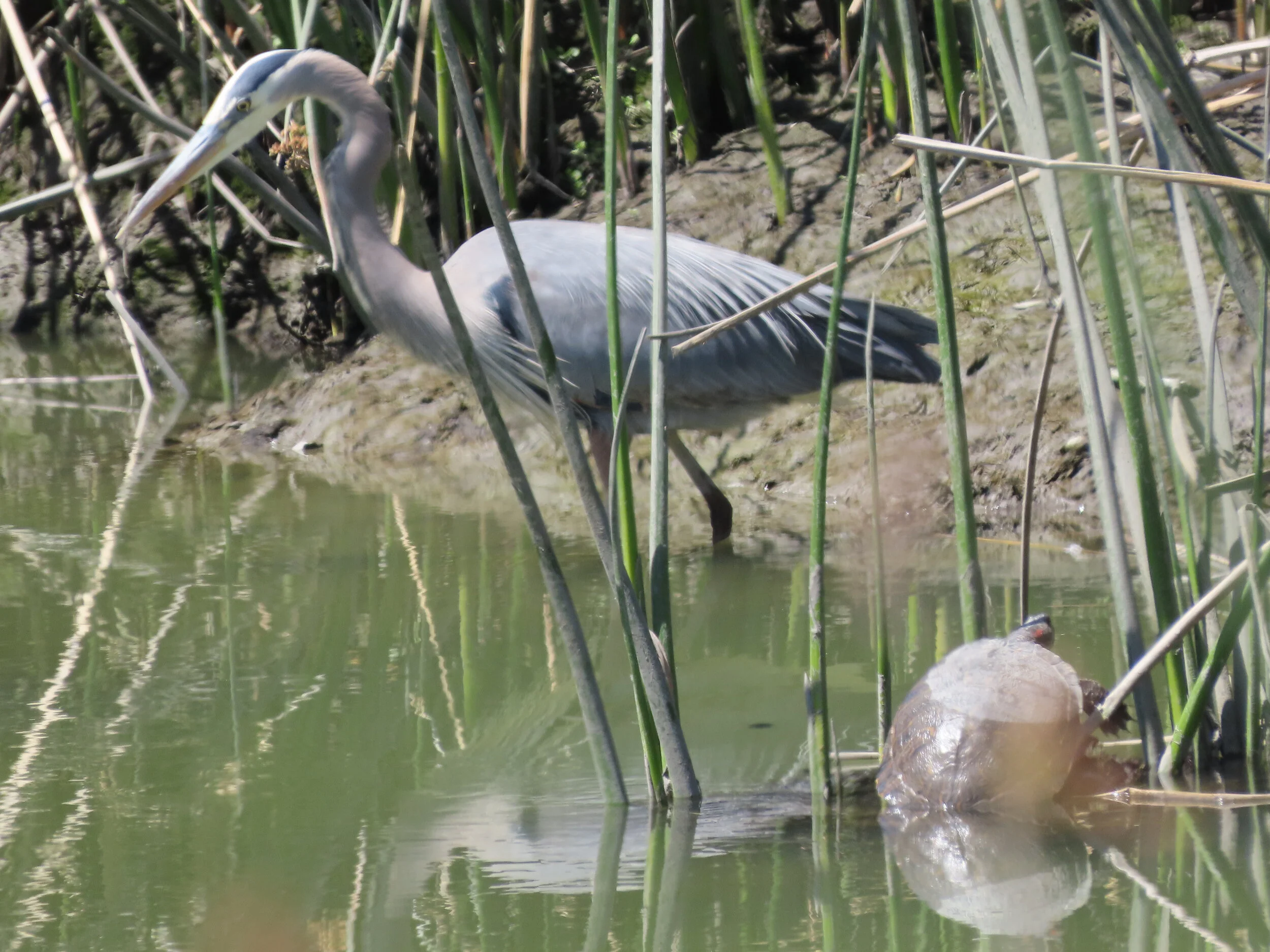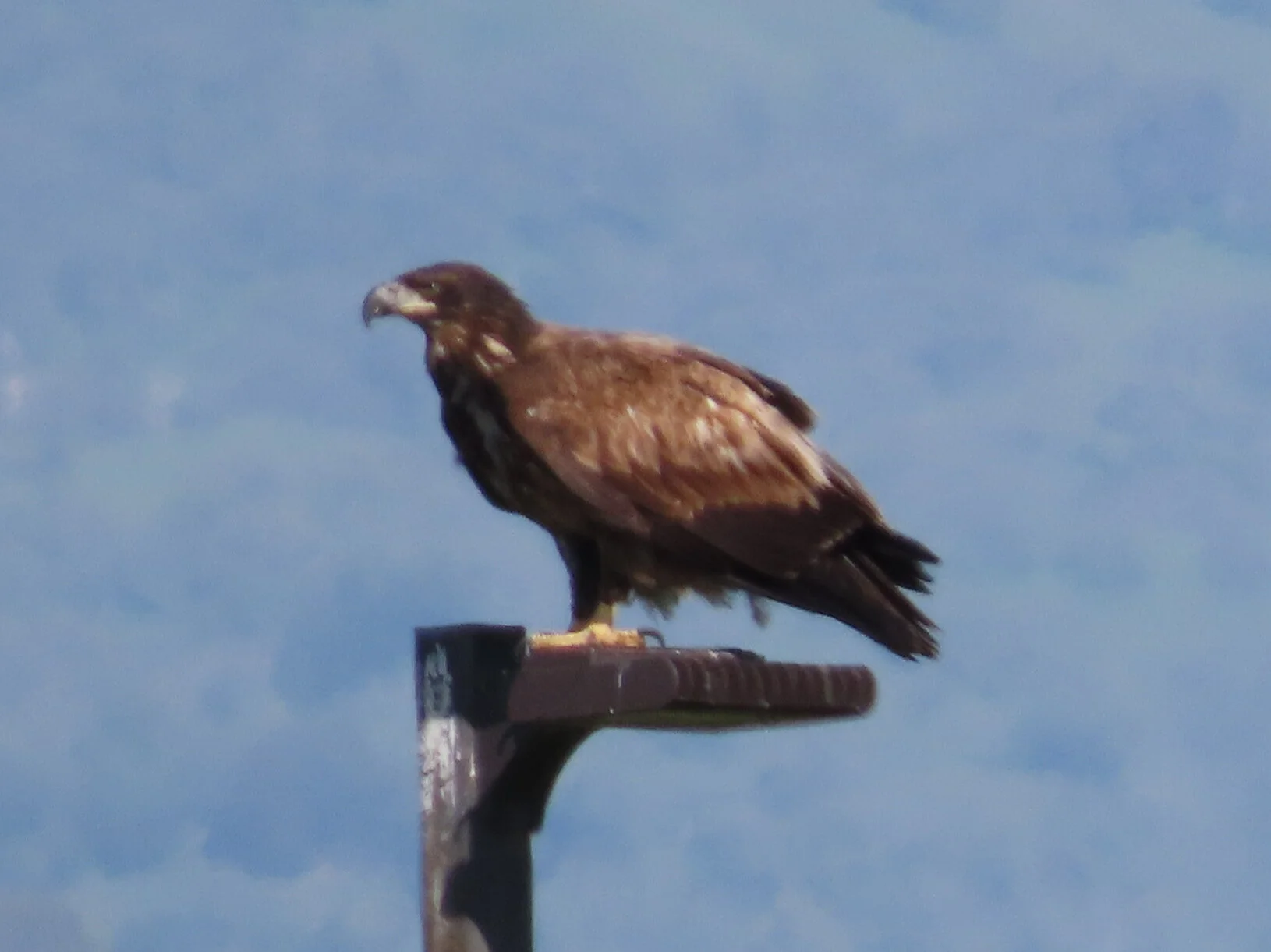Ginger and Barry masked up at McClellan Ranch
Once upon a time there was a tiny virus that made the whole world stop. And look out the window. And notice birds.
Okay, maybe not everyone became a birdwatcher during the pandemic…some became bread bakers and homeschoolers :-). But almost everyone got a lot more time to sit and reflect, with these circumstances forcing all of us to be more creative, to find different ways to connect with family and friends, to learn new technologies, to plan things we didn’t need to plan before and to adapt to the changed world we now live in.
COVID-19 warning at the Alviso Marina
This is a simple story of a Big Day in which COVID-19 colored everything. Despite the circumstances we still managed to have fun and see a lot of birds.
We decided in light of the stay-at-home orders that we would bird within our own 5-mile Radius (5MR), which meant that we were planning a birding Big Day where we were never more than 5 miles from our house at any point.
Sunrise with sundog at the Bubb Road Percolation Ponds
The concept of a 5MR pre-dates the virus, but the two work really well together. By staying closer to home, we are lowering the risk of exposure in the community. San Mateo County had even made an order saying to stay within 5-miles of your home and we thought there was some chance that Santa Clara would do the same, so planning for it was useful. The question though was: how many birds can we expect to find within our (extremely suburban) 5MR? Last year, Ginger and I set our personal record of 135 species within the county, but we traveled well out of our 5MR. We started by camping in the south county, and we birded both the east and west hills as well as the rich baylands.
Ginger recording birdsong
Well, it turns out even though suburbia surrounds us, we are within striking distance of the West Hills, some percolation ponds, many nice city parks, a couple rivers and the bottom edge of the San Francisco Bay. There are a lot of habitats in our circle, and a lot of eBird Hotspots.
Some of the eBird Hotspots in our 5MR
EBird is a free worldwide database of bird sightings. And it’s huge. Over 45 million checklists from around the world, a half-billion bird observations, all collected via citizen science and available to researches and the public alike. If you want to know where a bird is, you can type in it’s name and see everywhere it was last sighted. If you want to know where to bird, type in where you’re going and see all the best places to go. In addition to basic sighting information, eBird lets you upload photos of your observations as well, or song recordings if you have them. All of the birding we did this day is recorded in eBird (see checklists below).
Ring-necked Duck, Bubb Road Percolation Ponds
In total, we saw 106 species. We were surprised and delighted that we could get over 100 species so close to home. We learned a lot about our 5MR and we barely scratched the surface: we never went to the Guadalupe River or Ulistac Natural Area for example. The portion of Rancho San Antonio that we could have reached was closed for the virus. We skipped several great city parks (Central in Santa Clara, Las Palmas in Sunnyvale, Saratoga Creek Park, etc.). We will be visiting these other parks throughout the year, taking notes and making eBird checklists and improving our knowledge of the nature so close to home. There’s much left to explore!
Black Phoebe at Cuesta Park in Mountain View
eBird Checklists (with lots of bird photos of varying quality):
Great Blue Heron and Red-eared Slider (turtle) at the Sunnyvale Water Pollution Control Plant
Juvenile Bald Eagle on Disk Drive
Complete checklist for April 22, 2020, The Piratical Flycatchers Big Day Birdathon
Ducks, Geese, and Waterfowl
Canada Goose
Cinnamon Teal
Northern Shoveler
Gadwall
American Wigeon
Mallard
Ring-necked Duck
Greater Scaup
Bufflehead
Common Goldeneye
Ruddy Duck
New World Quail
California Quail
Pheasants, Grouse, and Allies
Ring-necked Pheasant
Grebes
Pied-billed Grebe
Pigeons and Doves
Rock Pigeon
Band-tailed Pigeon
Eurasian Collared-Dove
Mourning Dove
Swifts
Vaux's Swift
White-throated Swift
Hummingbirds
Anna's Hummingbird
Rails, Gallinules, and Coots
Common Gallinule
American Coot
Stilts and Avocets
Black-necked Stilt
American Avocet
Plovers and Lapwings
Killdeer
Sandpipers and Allies
Dunlin
Least Sandpiper
Western Sandpiper
Long-billed Dowitcher
Spotted Sandpiper
Greater Yellowlegs
Gulls, Terns, and Skimmers
California Gull
Caspian Tern
Forster's Tern
Cormorants and Shags
Double-crested Cormorant
Herons, Egrets, and Bitterns
Great Blue Heron
Great Egret
Snowy Egret
Black-crowned Night-Heron
New World Vultures
Turkey Vulture
Hawks, Eagles, and Kites
Northern Harrier
Cooper's Hawk
Bald Eagle
Red-tailed Hawk
Owls
Western Screech-Owl
Woodpeckers
Acorn Woodpecker
Nuttall's Woodpecker
Northern Flicker
Falcons and Caracaras
American Kestrel
New World and African Parrots
Mitred Parakeet
Tyrant Flycatchers
Pacific-slope Flycatcher
Black Phoebe
Western Kingbird
Vireos, Shrike-Babblers, and Erpornis
Hutton's Vireo
Warbling Vireo
Crows, Jays, and Magpies
Steller's Jay
California Scrub-Jay
American Crow
Common Raven
Tits, Chickadees, and Titmice
Chestnut-backed Chickadee
Oak Titmouse
Swallows
Northern Rough-winged Swallow
Tree Swallow
Violet-green Swallow
Barn Swallow
Cliff Swallow
Long-tailed Tits
Bushtit
Sylviid Warblers, Parrotbills, and Allies
Wrentit
Kinglets
Ruby-crowned Kinglet
Nuthatches
Red-breasted Nuthatch
White-breasted Nuthatch
Pygmy Nuthatch
Treecreepers
Brown Creeper
Gnatcatchers
Blue-gray Gnatcatcher
Wrens
House Wren
Marsh Wren
Bewick's Wren
Starlings
European Starling
Mockingbirds and Thrashers
Northern Mockingbird
Thrushes and Allies
Western Bluebird
Hermit Thrush
American Robin
Waxwings
Cedar Waxwing
Old World Sparrows
House Sparrow
Finches, Euphonias, and Allies
House Finch
Purple Finch
Lesser Goldfinch
New World Sparrows
Dark-eyed Junco
White-crowned Sparrow
Golden-crowned Sparrow
Song Sparrow
California Towhee
Spotted Towhee
Troupials and Allies
Western Meadowlark
Hooded Oriole
Bullock's Oriole
Red-winged Blackbird
Brown-headed Cowbird
Brewer's Blackbird
Great-tailed Grackle
New World Warblers
Orange-crowned Warbler
Common Yellowthroat
Yellow-rumped Warbler
Wilson's Warbler
Cardinals and Allies
Black-headed Grosbeak
